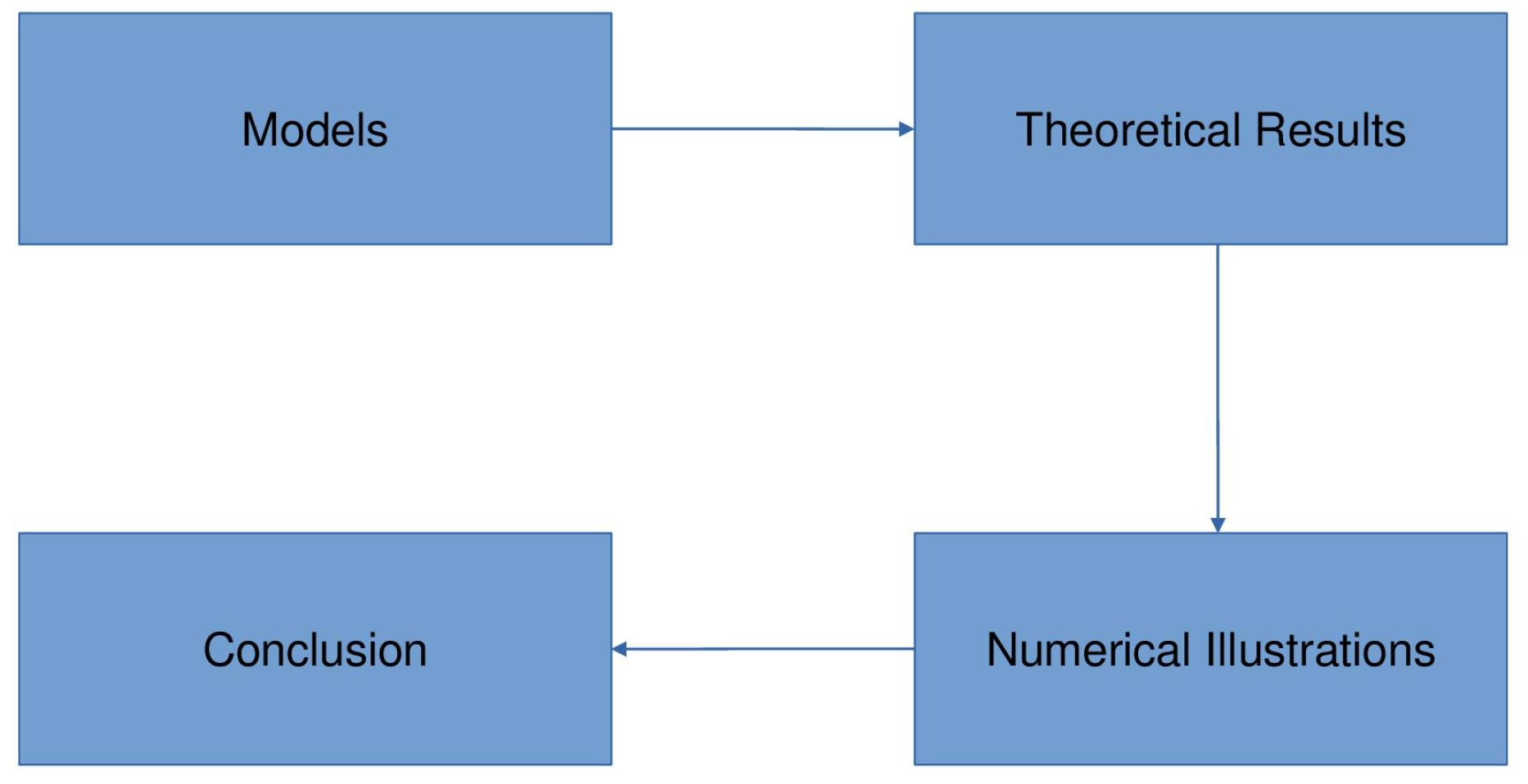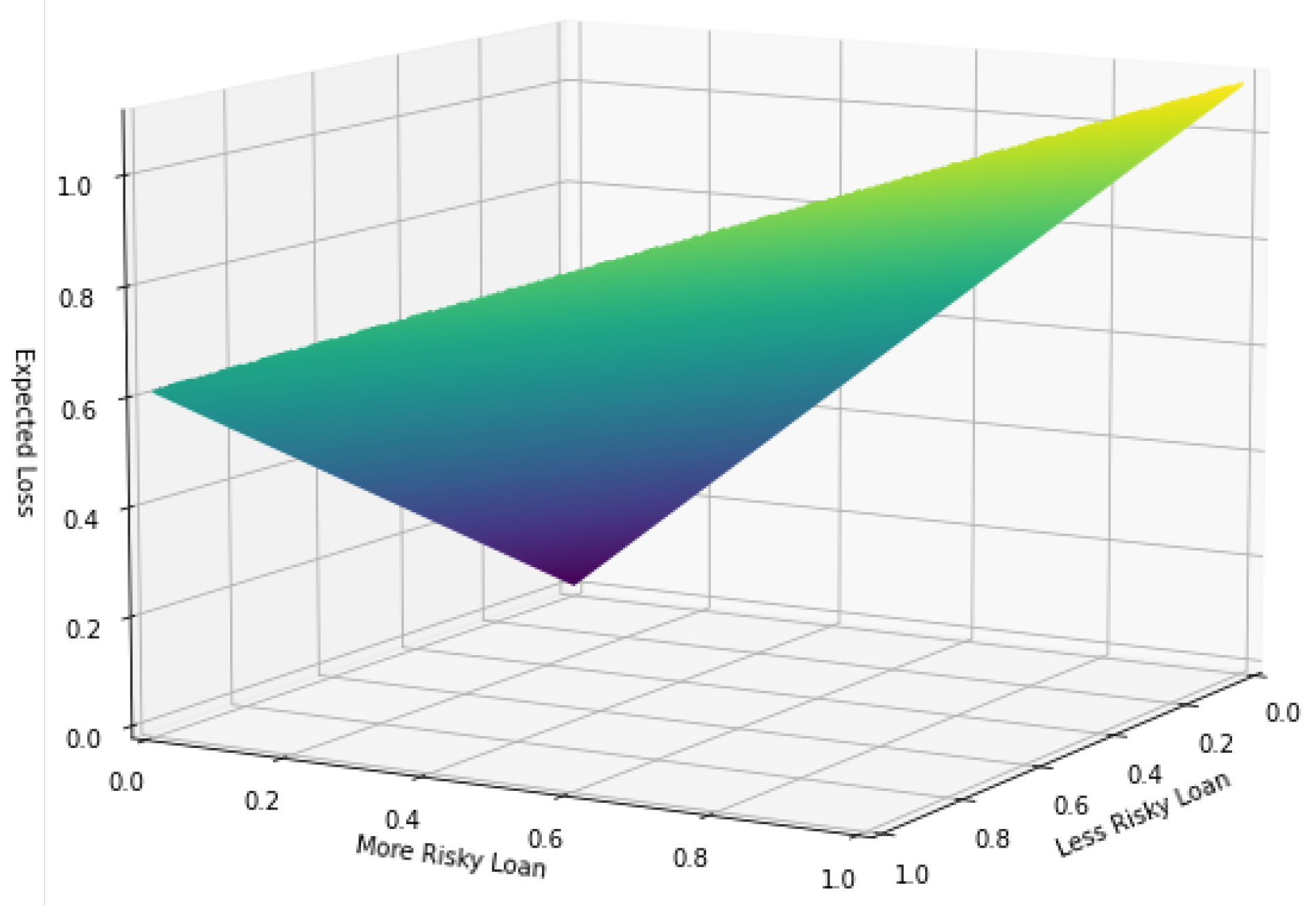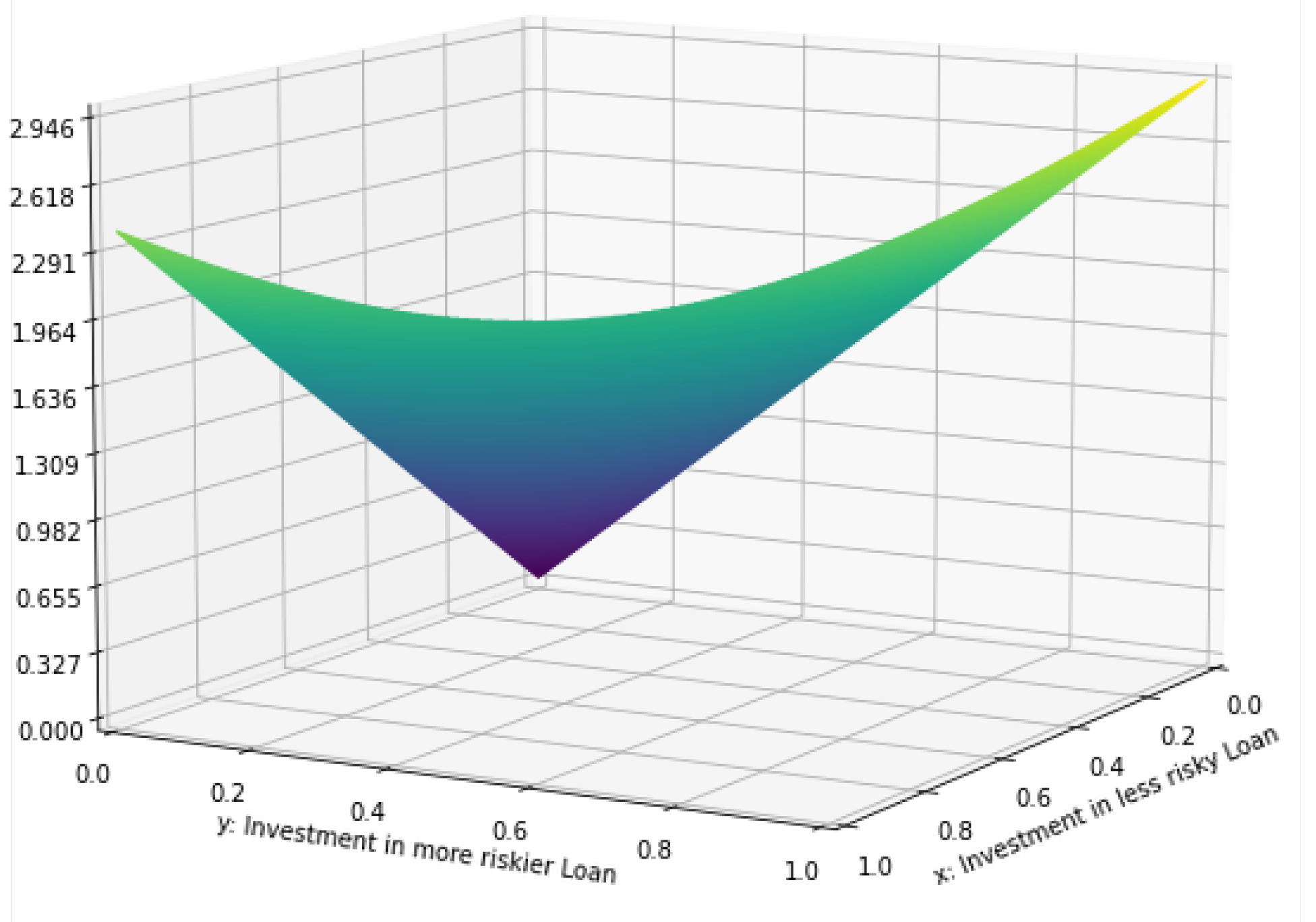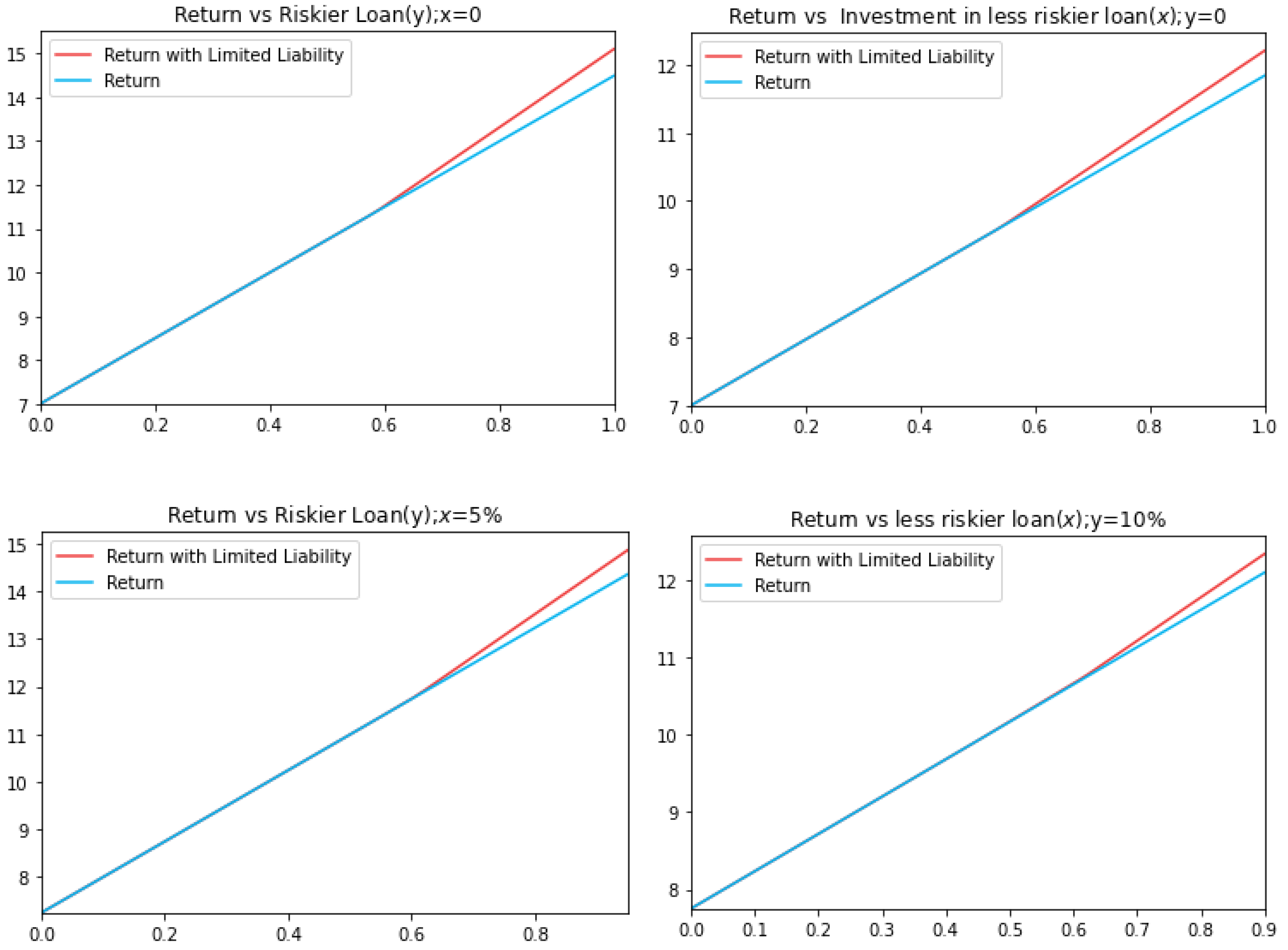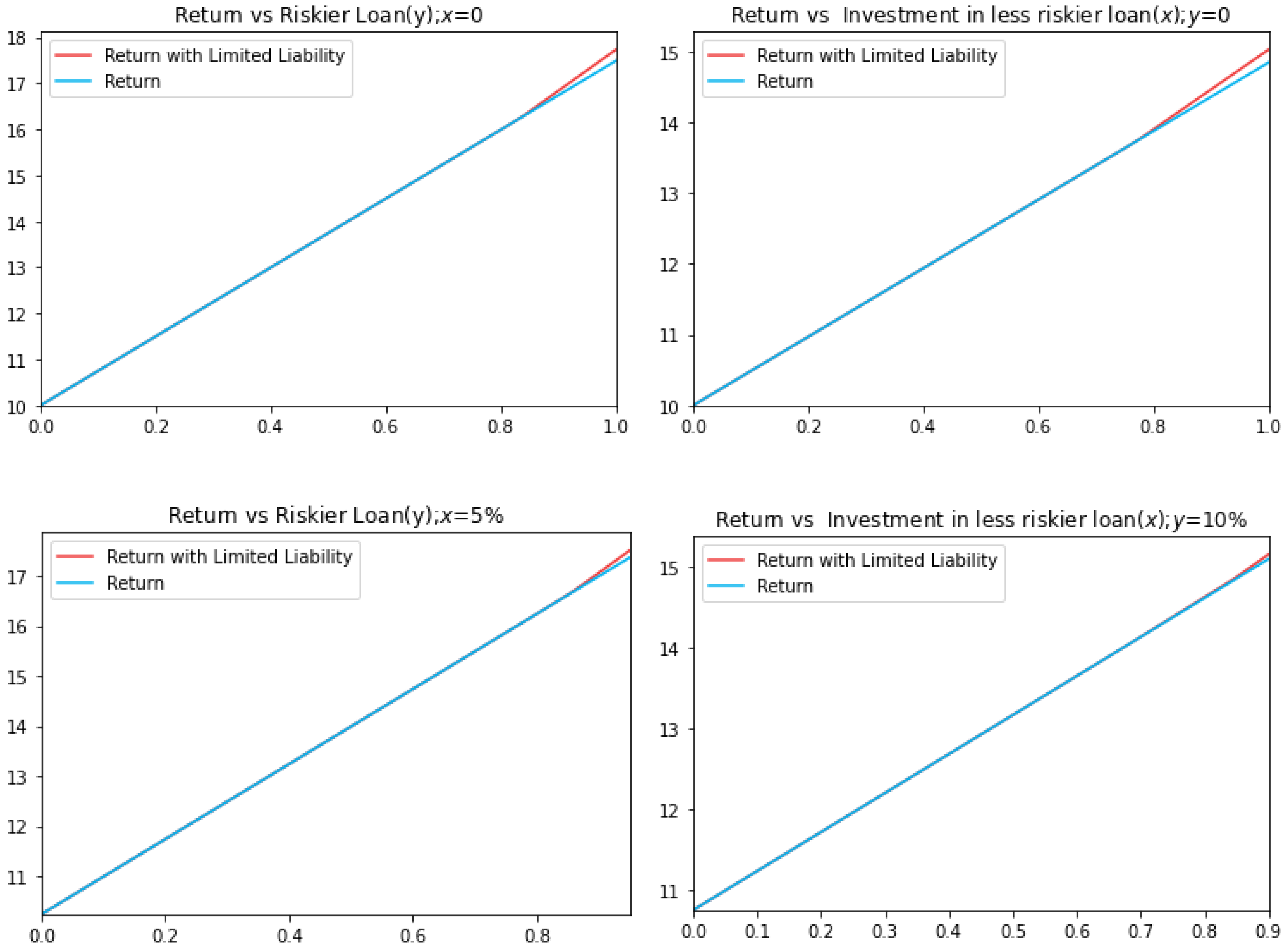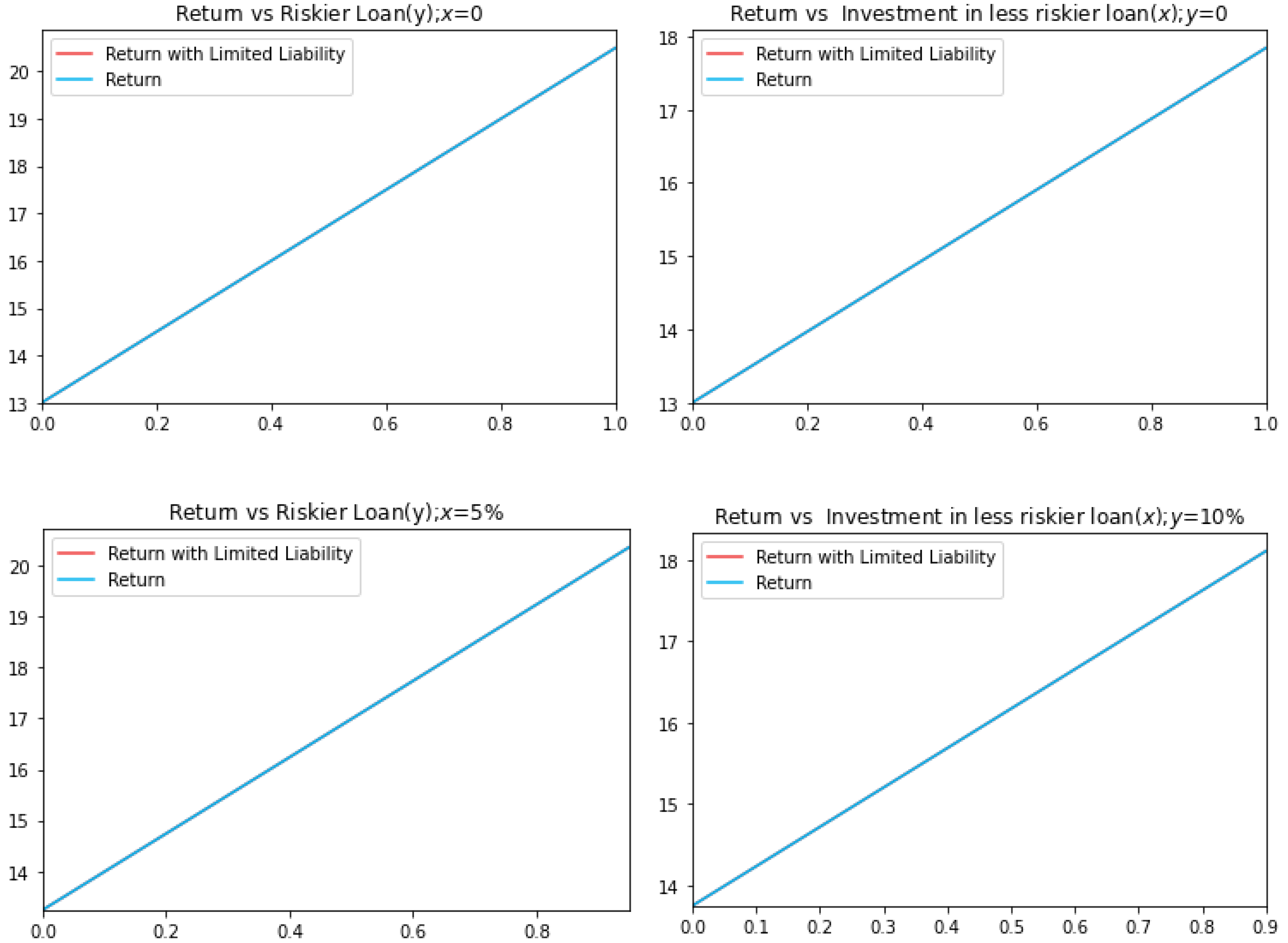1. Introduction
Bank leverage to a great extent may end up playing a vital role in triggering a financial crisis, as was the case with the spectacular financial collapse of 2008, which is now widely attributed to excessive leveraging by the prominent investment banks. Given the fact that many of these financial institutions, which were over-leveraged, had maintained a healthy level of capital requirement compliance, the regulators, namely the Basel Committee on Banking Supervision (BCBS) were prompted by this to set a target upper bound on the extent to which a bank can be leveraged (
Basel Committee on Banking Supervision 2014). Accordingly, they introduced a non-risk-based capital measure, namely the Leverage Ratio, to insulate the banks from over-leveraging, by way of capital requirements. Consequently, the Leverage Ratio is defined as
The numerator of “Capital Measure” in the definition is the Tier 1 capital of the risk-based capital framework, whereas the denominator of “Exposure Measure” is the sum of the exposures from the on-balance items, off-balance sheet items, derivatives and securities financing transactions (SFT).
The well-established approaches for the determination of capital requirements notwithstanding, the possibility of higher returns drives banks to greater risk exposure. Furthermore, it is possible that banks will tend to underplay the extent of the risk exposure to the supervisors, which, in the worst case, may even lead to bankruptcy. This problem and its step-by-step solution was discussed in (
Blum 2008). The problem of the limited ability of supervisors to decipher whether the bank disclosures are honest or not is shown to have an enforceable solution, by way of imposition of a risk-independent Leverage Ratio restriction. A World Bank report
D’Hulster (
2009) has elaborated upon the concept of leverage, and the necessity of the Leverage Ratio, to complement the already existent capital requirement framework, with the caveat of it (Leverage Ratio) being one of the several policy tools, in the paradigm of assessing the leverage buildup in a financial institution. In this context,
Hildebrand (
2008) highlighted the benefits of a Leverage Ratio, while recognizing the shortcomings. The benefits include the complementary non-risk-based nature and the simplicity, in terms of definition, application and monitoring, while the shortcomings include off-balance sheet exposure, profitability and pro-cyclicality.
Dell’Ariccia et al. (
2014) in their work related the low interest rate scenario with the leverage, as well as risk-taking by the banks. The authors concluded that when banks are accorded the leeway of determining their capital structure, reduction in interest rates lead to increased leverage, and consequently, higher risk, provided the loan demand function has a diminishing slope. However, in the case of fixed capital structure, the impact is contingent on the extent of the leverage. Subsequently,
Acosta-Smith et al. (
2020) worked on the bank’s decision problem, contingent on the Leverage Ratio restriction. In the model, the capital holding is considered, with all investment done in one risky asset, and all payments being done from the bank side. It was shown that every bank tends to hold less capital, which is otherwise very evident. Furthermore, one constant
was derived for each bank, depending upon the assets of the bank, therefore establishing a relationship with Leverage Ratio and risk-taking. Finally, it was noted that relative to a solely risk-based capital framework, the imposition of the Leverage Ratio requirement leads to lower probabilities of bank failure.
In
Kiema and Jokivuolle (
2014) and
Repullo and Suarez (
2004), the authors have categorized the loan types as high-risk loans and low-risk loans. Unlike the previous works, in this case, instead of considering the analysis of the portfolio of one bank, they have established the stability of the banks, by the expected number of bank failures, among the banks operating in the market. Further in the equilibrium (where the demand of loans and the supply of loans are equal, it is defined as the zero net value of the bank), they determined the relationship between the Leverage Ratio and the banks’ portfolio, with low-risk and high-risk loans. Finally, the papers also analyzed that higher Leverage Ratio increases the stability of the bank. As the Leverage Ratio increases, the number of high-risk loans decreases in the portfolio of the bank. Sale of bank loans can often be motivated by limitations resulting from regulatory requirements (
Carlstrom and Samolyk 1995). In the case of unregulated banks, there is enough incentive to extend loans and then sell off these loans to other banks, rather than adopt a more traditional approach of accepting deposits to fund these loans. Banks can extend credit only to the extent that regulators allow for. In this scenario, it is the approach of loan sales that is attractive for such banks (therefore going beyond the permissible regulatory limits) and for the banks which have room (from capital requirement perspective) for purchasing these loans. In practice, this amounts to capital buffer of non-local banks to support local projects routed through local banks.
The aspects of leverage and the consequent risk is intricately linked to risk-return paradigm of the portfolio of loans held by the bank (
Mencia 2012). Accordingly, the distribution of loan portfolios was studied sector-wise to encapsulate the cyclical characteristics of different types of loans and yields. The classical Markowitz approach is applied with a Value-at-Risk (VaR) constraint (to accommodate regulatory requirements), as well as the relationship maximization of the utility function. Furthermore, the model was also used to capture information about default correlations. In addition, this exhaustive study also included the determination of a no-arbitrage principle driven pricing of loans, taking into account the credit risk associated with the debtor. An optimization approach to the construction of a loan portfolio using VaR and Conditional VaR (CVaR) constraints is presented in (
Lee 2015). To this end, the basic approach of Lagrangian algorithm is employed, to determine the efficient frontier. An alternative approach of minimization of credit risk, in terms of expected loss is empirically analyzed in (
Cho et al. 2012). Accordingly, a methodology based on the Large Deviation Theory (LDT) is used for portfolio optimization, by taking into account, the heterogeneity of risk characteristic across different geographical locations. The key takeaway was the demonstration of a significant improvement in the performance of this approach, vis-a-vis other benchmark portfolios, with this improvement being achieved in terms of enhanced excess return and reduced credit risk. For a detailed description of portfolio management, in the presence of default risk, one may refer to the KMV document (
Kealhofer and Bohn 1998). The authors of the work enumerated the key aspects of this problem, and covered models of default risk, default correlation and value correlation. This is followed by risk contribution and its relationship to optimal diversification, as well as economic capital. They concluded with an accurate and detailed description of the risk of losses experienced in loan portfolios, by considering different “sub-portfolios”, of a typically very large portfolio of banks.
From a historical perspective, limited liability, in practice is achieved by way of a private contractual setup (
Carney 1998). It offers the advantage of safeguard of passive investors, from creditors, in the event of bankruptcy. In today’s economy, the implications of limited liability, as a source of moral hazard, is significantly evident (
Djelic and Bothello 2013). The authors of the work (
Djelic and Bothello 2013) strongly suggest the structural connect between moral hazard and limited liability, and highlighted the disruptive socio-economic consequences of the same. The question of dynamic moral hazard, resulting from the un-observable effort of an agent with limited liability, in terms of low frequency high magnitude losses is examined in (
Biais et al. 2010). The setup consisted of the agent and the principal, who (unlike the agent) has unlimited liability. An optimal approach, in terms of payments to the agent, is contingent on the good performance of the agent, in absence of which the payments are stopped. This is turn leaves room for both the extreme possibilities of the firm size diminishing to zero or experiencing unbounded growth. Limited liability, while acting as an incentive for investors, and facilitating economic growth, can have adverse consequences, such as risk-taking tendencies, therefore causing economic loss (
Simkovic 2018). Accordingly, the consequences of the latter can be sought to be mitigated through regulatory mechanisms (including capital requirements) and statutory insurance. An analysis of limited liability for insurance markets is studied in (
Boonen 2019), by considering limited-liability protection for non-life insurers. In particular, the case considered in the study is one where there is an exchangeable nature of insurance risk, in the case of policy holders. The author then goes on to establish the existence of a partial equilibrium in the insurance sector.
In this paper, we focus on the application of limited liability in the paradigm of four portfolio models, two of them incorporating the maximization of return (with and without limited liability) and the other two incorporating the minimization of risk (with and without limited liability). We derive the change in the Expected Loss, resulting from loan portfolio allocation (and connected with the resilience of the institution). For this work, we choose the risk measure to be the Expected Loss. The organization of the rest of paper is as follows. In
Section 2, we provide a description of the portfolio optimization models, with and without limited liability. In
Section 3, we present the fundamental motivation of the work through the presentation of our novel theoretical results. In
Section 4, we present two illustrative examples in support of our mathematical results. In particular, we present plots to demonstrate the sensitivity of Expected Loss, Unexpected Loss and returns vis-a-vis the portfolio allocation of the loans. Finally, in
Section 5 we present our conclusions and main takeaways from the work. This sequence of presentation, as described, is also shown in the following flow chart in
Figure 1.
3. Results
Here we begin with an important theorem.
Theorem 1. Investing more in risky asset increases Expected Loss and Unexpected Loss.
Proof. In this proof we use the formula used by
Kealhofer and Bohn (
1998), for the expected loss,
and for the unexpected loss,
where
and
and
are the Loss Given Default and Probability of Default, respectively, for the
i-th loan. Therefore, it is clear that risky loans have large
, as well as
, and hence increasing either or both, for a risky loan, also increases both EL and UL. □
Now we show that including limited liability in the model leads to out-performance of the models without limited liability. First, we show the minimization of risk model with and without limited liability.
Theorem 2. In the case of minimizing risk, Problem 4 outperforms Problem 2.
Proof. For a particular portfolio
x and a particular
k, we have,
Therefore
contains more points than
. In other words,
. Hence,
□
Now, to prove that Problem 3 outperforms Problem 1, we first establish the following Lemmas.
Lemma 1. In the solution of Problem 1, where .
Proof. is a monotonically decreasing function of
k (keeping
x fixed), since as
. Therefore, if
, then we obtain
which is a contradiction, since this objective function attains its maximum value at
. Hence
is impossible. However, since,
, hence we conclude that
□
Lemma 2. , where .
Proof. The proof follows from the fact that LHS in the inequality, is the maximum value of the function . □
Now let us come to the main result.
Theorem 3. In the case of maximizing expected return, Problem 3 outperforms Problem 1.
Proof. - Case-1:
We consider
, so that the above inequality becomes,
Therefore, by the Arbitrage Pricing theory (APT), contains more risky loans than .
- Case-2:
Next, we consider
and
. Now, since
, therefore,
as
is the optimal solution. Hence, this implies that
Therefore, by the APT, contains more risky loans than .
- Case-3:
We now consider
and
. Then
Now,
since
in this case. Now from the above two inequalities, we obtain
Therefore, by the APT, contains more risky loans than .
- Case-4:
We finally consider the case
and
. Accordingly, we obtain
Now we know that the function
, where
is the capital requirement for the
i-th loan
Kiema and Jokivuolle (
2014). Applying this in the inequality, we obtain,
Now since , therefore some of are negative, while some are positive. As the overall sum is positive, hence the positive terms have more weightage. Hence has more risky investment than .
Therefore, we can see that portfolio contains less riskier loans than portfolio , therefore producing much profit upon success of the bank. □
4. An Example
Financial institutions classify the investment instruments (loans, in this case), contingent on its quality, particularly its creditworthiness. The ranking of the loan seekers is executed through various grades, with the prominent ones being the ratings of S&P and Moody’s. In the context of our discussion, we construct an example to illustrate our theoretical results, presented in the preceding Section. As a model built-up, we consider a basic scenario of two kinds of loans, namely a safe loan and a risky loan. From the perspective of credit risk management, some of the factors which play a pivotal role in characterizing the loan are Probability of Default (PD), Exposure at Default (EAD), Loss Given Default (LGD), returns and the statutory capital requirements. The values of some of these parameters are available in articles (
Kiema and Jokivuolle 2014;
Shi et al. 2016) and publicly available on the websites of banks (
Landesbank Baden-Württemberg (
2008) and
Official SBI Website (
2018), for instance). Finally, motivated from (
Kiema and Jokivuolle 2014), we take the value of
.
For the illustrative example, we have constructed a loan portfolio of three loans, namely one which is completely safe while the other two are risky, with one of these two being riskier than the other owing to greater the probability of default and expected loss. The value of all the parameters are enumerated in
Table 3.
We consider another example as tabulated in
Table 4. In this example, we take
, with the decrement in Expected Loss being
and
, respectively, in the case of the risk minimization model and the expected return maximization model, resulting from the incorporation of limited liability.
Expected Loss plays the role of risk measure in our model. The formula (
Thomas et al. 2017) for the capital requirement for loans as a function of probability of default and loss given default, is given by,
where
Z is obtained as,
Here
is the cumulative standard normal distribution, while
is different for different types of loans (the details of which are available in (
Thomas et al. 2017)). For this work, we have taken
. We solve the minimization of risk model using “scipy” package of Python. Then, the model becomes,
subject to:
and
Here,
Solving this, we obtain the loan portfolio allocation of
with Leverage Ratio of
. On the other hand, solving for the model of minimizing risk, without limited liability, we obtain the loan portfolio allocation of
, again with Leverage Ratio
. Therefore, for this particular example, there is a
decrease in the expected loss due, resulting from the inclusion of limited liability.
For the next case, we illustrate the case of maximizing return with, as well as without limited liability. Accordingly, for this case, the model with limited liability will be transformed into a smooth optimization problem. We have given an upper bound of in Expected Loss for the problem. We have taken the Leverage Ratio to be . Solving this, we obtain a decrease in Expected Loss for changing this objective function in this example.
Now we come to the problem of maximizing return with and without limited liability. Then Problem 1 is easily solved, since all the functions in its objective functional and the constraints, are smooth. However, since the objective functional contains the “max”, therefore it is not differentiable. Accordingly, the steps of our methodology are as follows:
- (1)
Model Formulation: The model with limited liability (henceforth known as Model 1-L), which is not differentiable, is given by:
subject to,
Therefore, we transform this model into another problem which is differentiable. To do this we include some new variables, namely
,
,
and
, to handle the non-differentiability part. Accordingly, the new model (henceforth known as Model 1-L-NM) is given by,
subject to,
as well as,
- (2)
Transformation: The supremum of the objective functionals for the above problem has the same value. Let
and
be the objective functional of the above models. Therefore, the objective functional of the first problem is given by,
Let be the solution of Model 1-L. It also belongs to the feasible set of the Model 1-L-NM, with suitable values of , , and .
Let
attain its maximum at
. Now,
and the constraint involving
does not involve
excluding
i. Therefore, any change in
does not affect
. From Equation (
1), we see that
increases with
. Hence
takes the largest value in the region allowed by the constraint. Therefore,
. Consequently, we obtain
As the restrictions on
are the same in both the problems, hence we obtain,
since
maximizes the
. Let us calculate
and
. Furthermore, we denote
. As
maximizes the
, hence we obtain
and,
as,
Therefore, from Equations (
2) and (
3), both the problems have the same supremum. If Model 1-L has a unique solution, then we obtain
.
In the example, we have taken three loan portfolios, one of which is completely risk-free. One of the remaining two is less risky (say
) and the remaining one is riskier (say
). In
Figure 2, we have shown the change in Expected Loss against the change of investment in risky loans, where the
x-axis presents the investment in
and
y axis represents the investment in
. Additionally,
represents the investments in a completely safe loan. Therefore
contains all possible portfolios. From the image we see that increasing investments in risky loans increases the Expected Loss. Full investment in the completely safe loan gives an Expected Loss of
. In the case of full investment in
and
, the resulting Expected Losses are
and
, respectively.
Now, we discuss the change in the expected loss. The sensitivity of unexpected loss is given in
Figure 3 with the investments in risky loans. Full investment in
and
, results in Unexpected Loss of
and
, respectively.
Next, we show the change in return with and without limited liability. We have shown the change in returns by fixing
x (investment in
) fixed at
and
in two images and then another two keeping
y (investment in
) fixed at
and
. These four cases are done by keeping Leverage Ratio (
k) at
(
Figure 4),
(
Figure 5) and
(
Figure 6).
Now there are four scenarios of realizations (denoted by
= 1:4), for the two risky loans, namely both the loans are repaid (
), only
defaults (
), only
defaults (
) and both the loans default (
). In
Figure 4, we have plotted the returns profile when the Leverage Ratio is
. In this case, let us assume that the bank has invested total wealth of
(
). Therefore, if
defaults, the value of bank becomes
, which is negative. Therefore, the bank fails to meet its liabilities. In
Figure 5, we have plotted the returns profile when the Leverage Ratio is
. In this case, let us assume that the bank has invested total wealth to
. Therefore, if
defaults, the value of bank becomes
, which is negative. Therefore, the bank again fails to meet the liabilities. The same consequences would be observed if the bank invests all its money to
(
). When the Leverage Ratio is
, the loss in the worst case is less than that for the case in which the Leverage Ratio is
. If there is a penalty associated with the default and it is proportional to the amount of loss, then keeping a
Leverage Ratio causes less penalty in the case of failure. In
Figure 6, we have shown the change in return with keeping the Leverage Ratio at
. It is an interesting case, in the sense that even with the entire investments in
or
, the bank can survive the worst cases, due to the Leverage Ratio being
. We can see that banks can survive all worst cases for the possible portfolios for this parameter value of the loans. From the graph, we see that there is no gap between the two lines. Therefore, an increment in the Leverage Ratio increases bank stability and consequently decreases in terms of the gap between the two lines.
5. Conclusions
Banks and other significant financial institutions have limited-liability protection. However, in the literature discussed, the decision process usually goes through the classical framework, whereby the profit is measured via the Expected Return or utility functions of the realizations, in conjunction with the risk profiles. However, typically, the notion of limited liability is not considered in the model which is used to make the decision. To this end, this article is focused on the approach of incorporating limited liability in the model setup. We theoretically establish the benefit of limited liability for both the objectives of profit maximization and risk minimization.
We have shown the comparative analysis between the models, for maximization of Expected Return, without limited liability (Problem 1) and with limited liability (Problem 3), with the same upper bound on risk for both. Furthermore, (Problem 2) and (Problem 4) minimizes risk without and with limited liability, respectively, while keeping identical lower bound for the Expected Return, for both.
Moreover, the analysis shows that in the case of the first comparison, the model with limited-liability protection has less risky loans than the model without limited liability, which supports the result obtained in Theorem 3. In the case of the second comparison, risk can be more minimized using the limited liability as the lower bound on the return with limited liability, as predicted in Theorem 2.
Therefore, from a practitioner point of view, using limited liability in the decision model can help make the right investment decision, as limited-liability protection reduces the amount of risk for the banks. Therefore, the construction of the portfolio, which meets the criteria of the investments (threshold level of profit or risks) and incorporates limited liability, is undoubtedly a more valuable and realistic model for the actual scenario.
